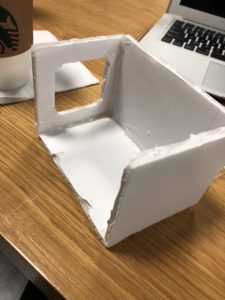When Aaron was talking about some example projects that could be made to fit this week’s assignment task, I was very puzzled. I kept trying to think of ideas that are original and creative at the same time. I wracked my brain and couldn’t think of anything. I resorted to talking to one of my close friends about not being able to think of any ideas and her reply to my frustration was to “do something that you know how to do best”. Therefore, this project contains some elements that I know how to do well – no, unlike the what the title suggests, I am not a thief. I, on the other hand, know how to annoy my friends.
I, therefore, wanted to make something that could potentially annoy others (what better way than to do that with noise, am I right?) and have a practical use. Thinking of what I could do with a buzzer and an LED, I thought of making something that would surround an object so that when (let’s say that you have a cat) your cat tries to steal your box of cereal, for example, the shadow of the cat, when close enough, will cause the buzzer to sound and the lights to turn on.
The midway process video is shown below, where I first coded so that the darker the surroundings, the brighter the LED would get. I couldn’t figure out how to make the initial no-shadow/darkness situation be that so the LED was turned off. It was only after that I realised an extra section of calibration was required – which I implemented into the code (link below).
I originally wanted to put the Arduino and breadboard into a box so that it looks more “discrete” in practical terms and so made this box. I didn’t end up using it though because I couldn’t manage to control the LED light levels (even with calibration) and make it stay off initially and only turn on when a shadow “approaches” the object. I realise now that I’m writing this that I could put the photoresistor on the outside of the box so that it sticks out like I originally wanted the LED to do. Nevertheless, I didn’t end up using the box. I guess one good thing about not using the box is that I got to see my code work “properly” in the sense that originally, it was quite hard to see the changes in the brightness of the LED. Putting it in a box would’ve made it even harder to notice the changes due to the initial brightness being low already. I was able to see that my code was working properly.

After the process shown in the video above, I connected the buzzer to the circuit and wrote code that basically said that if the LED was at the brightest, the buzzer would sound on. Meaning that when the cat/person was closest to the object (in this case, the board) the lights would turn on and the buzzer sound on. I thought that this could potentially be a way for the cat to be scared away.
The link to the code that I have used is shared here: https://gist.github.com/hyl392/89a6ec6ec6048540b7b143b29a2ef3ae
The video of the final product is here:
I didn’t realise how sensitive the photoresistor would be. I ended up having so much fun with my assignment that I’m sure I disturbed the whole lab with my annoying buzzer noise. But hey, like I mentioned before, annoying people is what I know how to do.
Quick sorry to everyone who was in the lab while I was playing around with the code and then further messing and fooling around with shadow!
Improvements:
- Use more LEDs so that there is more scare effect
- Blinking LEDs so that it looks more like an alarm?
- Change the buzzer into a speaker and play some really annoying alarm sounds that would annoy all humans and animals
- Make the whole thief preventer more discrete so that the thief would not expect an alarm to sound and lights to light up – i.e. incorporate the box into the project and make it a lot more practical (though the USB would still need to be plugged into my computer so I’m not sure how it’ll work).
